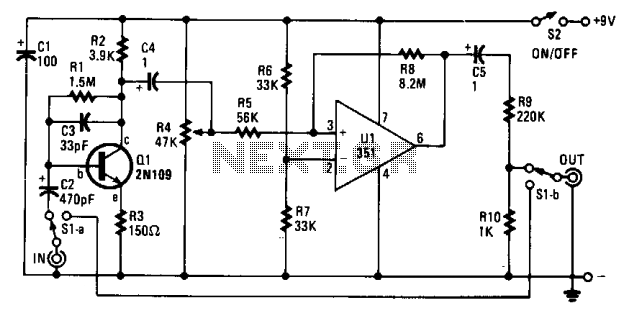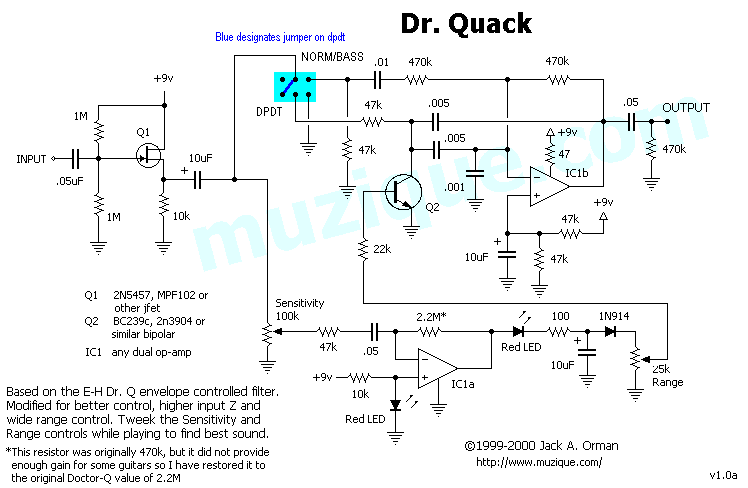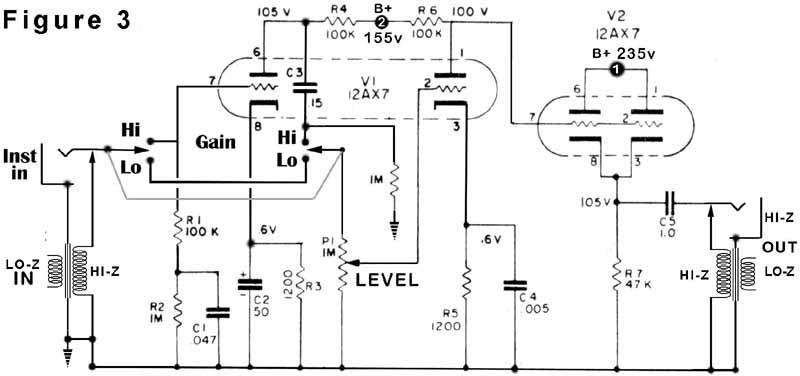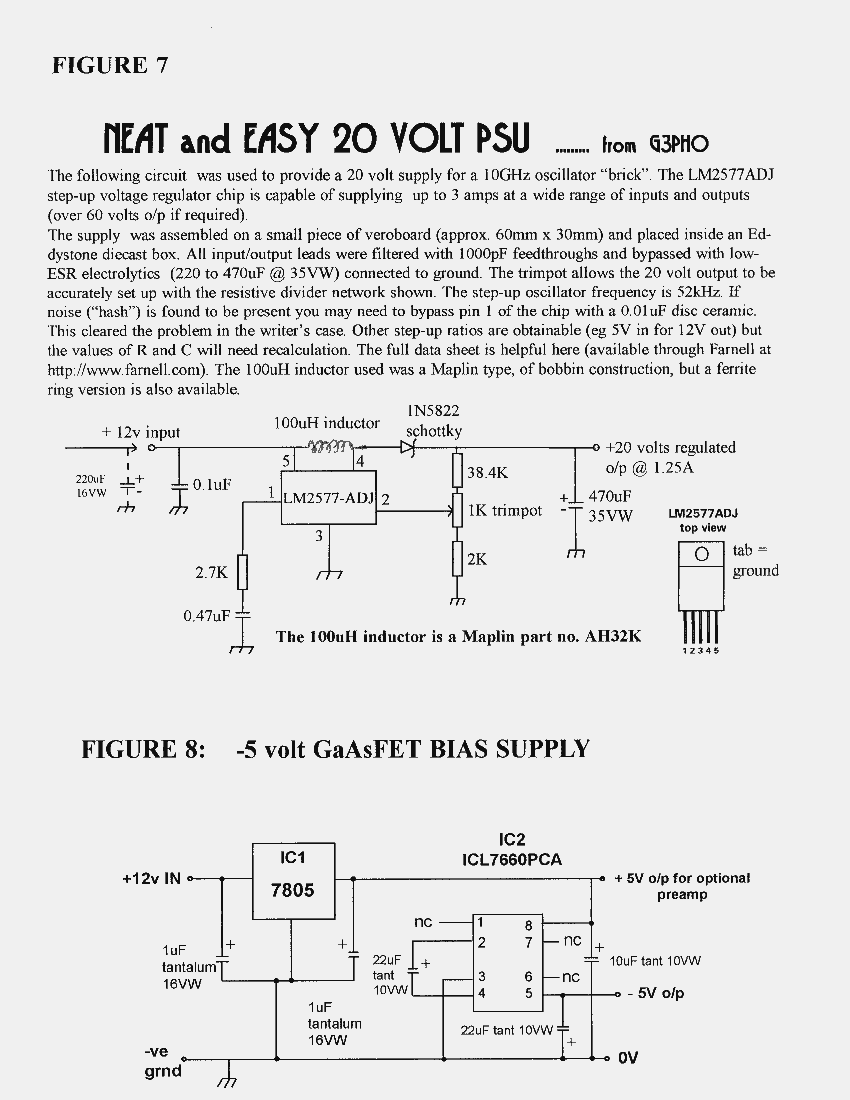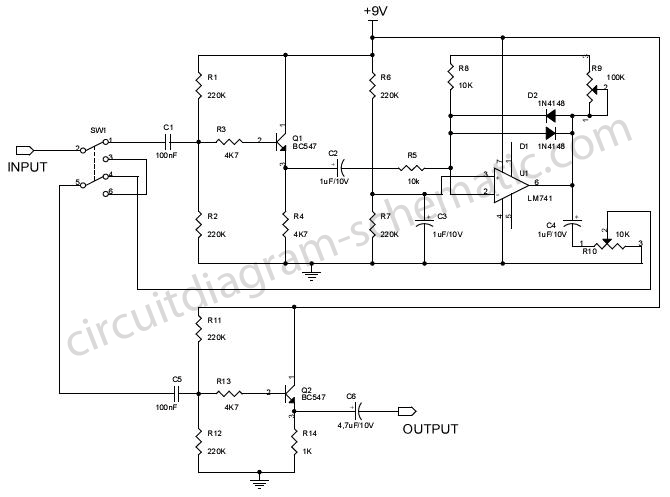
Fuzz box 1
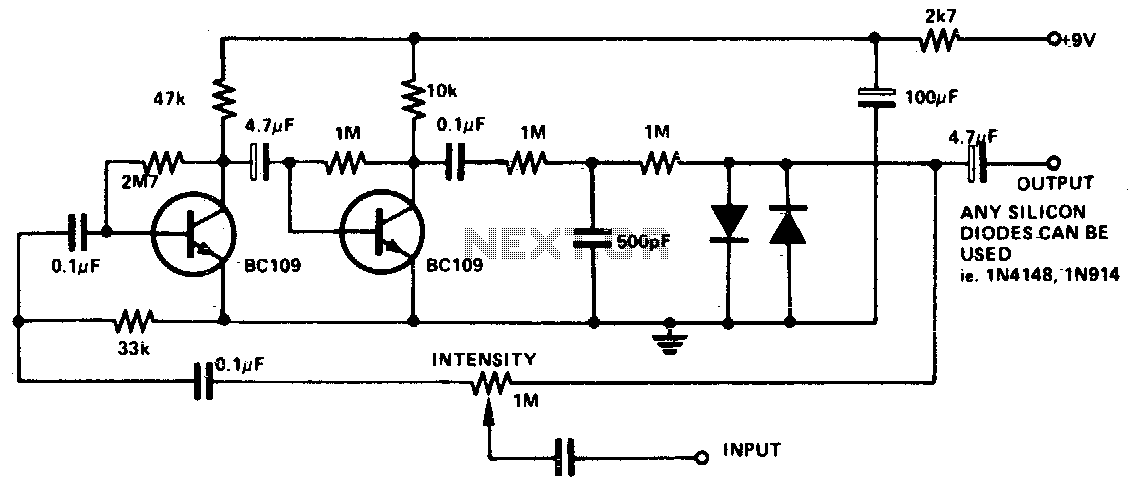
The input signal is amplified by the transistors. The distorted output is then clipped by the two diodes, and the high-frequency noise is filtered from the circuit via the 500 pF capacitor. The 1 M potentiometer adjusts the intensity of the fuzz from maximum to no fuzz (normal playing).
The circuit described functions primarily as a fuzz effect pedal, commonly used in electric guitar applications. The initial stage of the circuit involves a transistor amplifier configuration, where the input audio signal is fed into one or more transistors. These transistors are configured to amplify the input signal, which introduces distortion due to the non-linear characteristics of the transistors when driven beyond their linear operating range.
Following amplification, the distorted output signal is subjected to clipping through two diodes. This clipping process is essential in shaping the fuzz effect, as it limits the voltage peaks of the signal, creating the characteristic sound associated with fuzz pedals. The choice of diodes can significantly influence the tonal quality of the output; silicon diodes typically yield a sharper clipping, while germanium diodes produce a smoother, warmer distortion.
To ensure that the output signal remains clean from unwanted high-frequency noise, a 500 pF capacitor is employed. This capacitor acts as a low-pass filter, effectively shunting high-frequency components to ground while allowing the desired audio frequencies to pass through. The placement of this capacitor is crucial, as it helps maintain the integrity of the fuzz sound by preventing harsh noise artifacts from interfering with the output.
Additionally, the inclusion of a 1 MΩ potentiometer allows for user control over the fuzz intensity. This potentiometer adjusts the gain of the circuit, providing a range from maximum fuzziness—characterized by a heavily distorted sound—to a clean tone, which is ideal for normal playing situations. By turning the potentiometer, the player can seamlessly transition between different sonic textures, making the circuit versatile for various musical styles.
Overall, this circuit design effectively combines amplification, distortion, clipping, filtering, and user control to create a dynamic and expressive fuzz effect suitable for electric guitar applications.The input signal is amplified by the transistors. The distorted output is then clipped by the two diodes and the high frequency noise is filtered from the circuit via the 500 pF capacitor The 1 M pot adjusts the intensity of the fuzz from maximum to no fuzz (normal playing). 🔗 External reference
The circuit described functions primarily as a fuzz effect pedal, commonly used in electric guitar applications. The initial stage of the circuit involves a transistor amplifier configuration, where the input audio signal is fed into one or more transistors. These transistors are configured to amplify the input signal, which introduces distortion due to the non-linear characteristics of the transistors when driven beyond their linear operating range.
Following amplification, the distorted output signal is subjected to clipping through two diodes. This clipping process is essential in shaping the fuzz effect, as it limits the voltage peaks of the signal, creating the characteristic sound associated with fuzz pedals. The choice of diodes can significantly influence the tonal quality of the output; silicon diodes typically yield a sharper clipping, while germanium diodes produce a smoother, warmer distortion.
To ensure that the output signal remains clean from unwanted high-frequency noise, a 500 pF capacitor is employed. This capacitor acts as a low-pass filter, effectively shunting high-frequency components to ground while allowing the desired audio frequencies to pass through. The placement of this capacitor is crucial, as it helps maintain the integrity of the fuzz sound by preventing harsh noise artifacts from interfering with the output.
Additionally, the inclusion of a 1 MΩ potentiometer allows for user control over the fuzz intensity. This potentiometer adjusts the gain of the circuit, providing a range from maximum fuzziness—characterized by a heavily distorted sound—to a clean tone, which is ideal for normal playing situations. By turning the potentiometer, the player can seamlessly transition between different sonic textures, making the circuit versatile for various musical styles.
Overall, this circuit design effectively combines amplification, distortion, clipping, filtering, and user control to create a dynamic and expressive fuzz effect suitable for electric guitar applications.The input signal is amplified by the transistors. The distorted output is then clipped by the two diodes and the high frequency noise is filtered from the circuit via the 500 pF capacitor The 1 M pot adjusts the intensity of the fuzz from maximum to no fuzz (normal playing). 🔗 External reference
